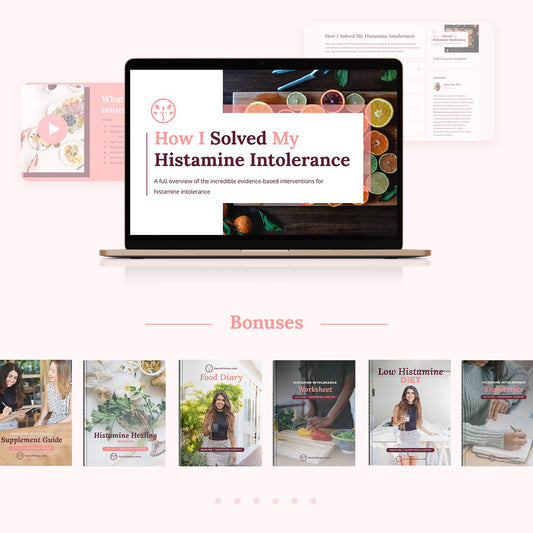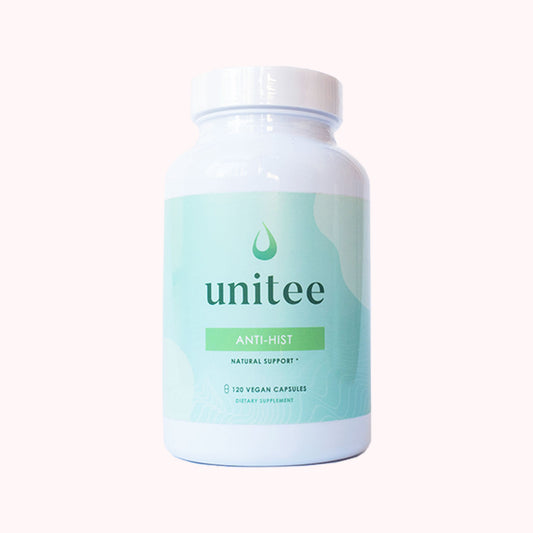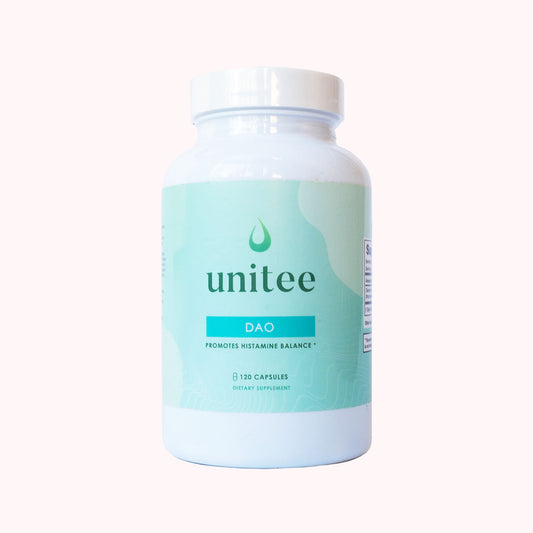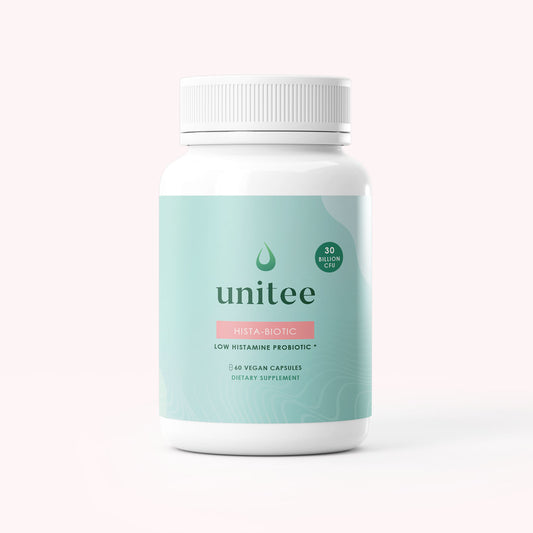Kohl… what? Kohl-rabi!
This green vegetable might sound like an exotic food that needs to be avoided while following a low histamine diet, but au contraire! It’s simply a cruciferous vegetable with an exotic name. It’s a cousin of the broccoli, cabbage, cauliflower and turnip and is also commonly known as a German turnip. But no matter what you decide to call it, be sure to call it low histamine!
While you may see some sources mention it as histamine-containing, the levels typically found in kohlrabi are far below any level that would be considered a trigger, and so is definitely considered a low-histamine food.
Now you know the answer to the question, “Is kohlrabi low histamine?”, let’s get into the reasons you should include it in your diet.
Kohlrabi Is Low Histamine, but Also Really Nutritious!
There are a handful of amazing health benefits kohlrabi offers for those following a low histamine diet.
It’s high in vitamin C, which is not only a great antioxidant vitamin that helps to reduce the effects of inflammation on your tissues, you may already be well aware of the role vitamin C plays in reducing histamine levels (1). As a reminder, vitamin C is a critical cofactor in the production of the histamine-degrading enzyme diamine oxidase (DAO). It has also been shown to have mast cell stabilizing effects, and it’s no wonder that those with low levels of vitamin C are at a higher risk of developing histamine intolerance in the first place.
Another important vitamin known to reduce the symptoms of histamine intolerance is vitamin B6. You guessed it, you’ll find kohlrabi as a great source of this all-important vitamin. B6 plays a role in immune health, production of your oxygen-carrying red blood cells, and helps to ensure your body can use proteins optimally. When it comes to histamine intolerance, vitamin B6, like vitamin C, contributes to the production and function of DAO (2).
Kohlrabi is also considered a low glycemic food meaning it has little effect on your blood sugar levels. It is low in carbohydrates with 1 cup of kohlrabi containing only 8 grams of carbs, which is a real bonus when you’re living with histamine intolerance and blood sugar spikes and dips trigger histamine flares! It’s also high in fiber, further reducing the effect these 8 grams of carbs have on your blood sugar. In fact, with 5 grams of fiber it means 1 cup of kohlrabi has only 3 net carbs, making it a seriously low carb food for the volume you can eat.
The fiber content is quite significant when it comes to your gut health. And we all know how important gut health is in relation to histamine intolerance (3)! Fiber from food feeds the all important bacteria living in your digestive tract so they can produce essential nutrients like short chain fatty acids (SCFAs) which maintain the health of your gut and support your immune system (4). Supporting your gut health and immune system has a profound effect on mast cells. By reducing inflammation and the production of inflammatory compounds as well as increasing the production of SCFAs, fiber has been shown to have beneficial effects on mast cell associated disorders such as histamine intolerance (5).
You’ll also get a little potassium, magnesium, manganese and folate, all of which are important minerals and vitamins that contribute to your overall health.
Right! We’ve covered the health benefits of kohlrabi. But you may now be wondering how you use this unusual vegetable…
Adding Low Histamine Kohlrabi to Your Diet in Fun and Easy Ways
First things first. Whenever you introduce a new food into your low histamine diet, it’s important to do so slowly. And even though kohlrabi is considered a low histamine food, it too needs to be introduced slowly if you’ve never used it before. Some of you with histamine intolerance are also sensitive to brassica vegetables, so introducing kohlrabi slowly allows you to test your tolerance and, if you don’t have any reactions, you can then make it a staple!
If you’re particularly sensitive to histamines, you can lightly boil or steam the kohlrabi, which not only makes it easier to digest, it lessens the histamine content because heat breaks histamines down.
Now for the fun part. Here are seven ways you can include kohlrabi into your low histamine eating plan.
1. Chips. Thinly slice your kohlrabi - using a microplane would be best - then lightly drizzle with olive oil and a pinch of salt. Roast in the oven until lightly browned and the chips have reached the desired crispness.
2. Fries. Just as you would make chips, you can make kohlrabi fries. Simply cut your kohlrabi into fry-sized strips, coat in oil and a little salt, and roast in the oven until golden brown. .
3. Roasted veg side. Kohlrabi makes a really tasty side dish, no matter how you eat it, but one of the easiest ways to include it into your low histamine diet is to roast it and add it to any of your meals. Cube your kohlrabi, drizzle in olive oil and dress with a little salt and place in the oven until soft and slightly browned. Use it hot, or allow it to cool in the fridge and eat it later as a snack. While roasting does bring out the sweetness of any vegetable, if you find kohlrabi a little too much on the peppery side, you can always add a touch of honey, which helps to bring out its sweetness even more.
4. Fritters. Bring some fun into your low histamine meals with kohlrabi fritters. Squeeze as much moisture out of 1 whole peeled and grated kohlrabi and thoroughly combine with an equal amount of peeled and grated carrots, a couple of chopped chives and green onion tops, two eggs and a little salt. Fry 2 tablespoons each of fritter batter in a little olive or coconut oil until golden brown and the outside looks crispy. Serve with this low histamine cauliflower hummus.
5. Slaw. Grate ½ a peeled kohlrabi and add to ½ a grated apple. If tolerated, add a small handful of chopped and lightly toasted macadamia nuts and a couple of tablespoons of apple cider vinegar for a low histamine slaw. If you want a thicker, mayonnaise-like sauce, add a couple of tablespoons of coconut cream and a little salt.
6. Soup. Grate the kohlrabi, add coconut milk and your favourite low histamine herbs and spices such as parsley, dill, mint, rosemary, thyme, or chives. Boil the mixture until the kohlrabi is soft, then blend together into a puree and you have a delicious, nutritious low histamine meal. Serve with this low histamine pizza base which you’ll cook in the oven for 15-20 minutes without the sauce and toppings!
7. Thickening. You can use kohlrabi to thicken sauces, soups or smoothies as a low carb, low histamine option. Grate the kohlrabi, add it to your choice of the above and, once softened, puree in a blender. When adding to a smoothie, as with the roasted vegetables, add a touch of honey to reduce kohlrabi’s peppery taste and instead, bring out its sweetness.
There you have it! I hope I’ve answered your question: is kohlrabi low histamine?
Along with the evidence of its health benefits, you can now confidently brighten up your low histamine diet by including kohlrabi in any or all of these delicious ways.
References:
1. Jochum C. Histamine Intolerance: Symptoms, Diagnosis, and Beyond. Nutrients. 2024;16(8):1219.
2. Maintz, L., & Novak, N. Histamine and Histamine Intolerance. The American Journal of Clinical Nutrition. 2007. 85(5):1185-1196
3. Schnedl WJ, Enko D. Histamine Intolerance Originates in the Gut. Nutrients. 2021;13(4):1262.
4. Silva, Y., Bernardi, A., & Frozza, R. The Role of Short-Chain Fatty Acids From Gut Microbiota in Gut-Brain Communication. Front. Endocrinol. Sec. Neuroendocrine Science. 2020. Vol 11.
5. Folkerts J, Stadhouders R, Redegeld FA, et al. Effect of Dietary Fiber and Metabolites on Mast Cell Activation and Mast Cell-Associated Diseases. Front Immunol. 2018;9:1067.

Anita Tee
My name is Anita Tee. I'm a nutritional scientist who specializes in histamine intolerance. I hold a Master of Science in Personalized Nutrition and a Bachelor of Science in Human Biology and Psychology.
For the past ten years, I have used my experience in nutritional and medical health sciences to create a scientifically backed, natural approach to healthcare that relies 100% on evidence-based research.
As I previously suffered from - and overcame - histamine intolerance, my focus is to increase recognition and expand the available resources and protocols available for resolving this particular disorder. To date, I have helped over 4,000 individuals fully resolve or better manage their histamine intolerance symptoms.







